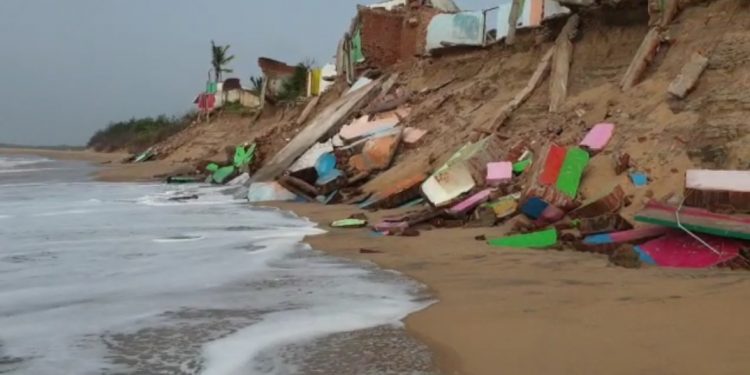Chhatrapur: At a time when surging tidal waves are eating into the land mass in coastal areas of Ganjam district, the state government has decided to tie up with Chennai based-National Institute of Ocean Technology (NIOT) to curb the menace, a report said. The state government has approved a proposal for the signing of a memorandum of understanding (MoU) with NIOT which functions under the Union Ministry of Earth Sciences. The pact will be inked soon with NIOT, which will provide necessary technical assistance to combat erosion along the coast. The matter came to the fore when Ganjam Collector Dibya Jyoti Parida informed the media persons, Monday, about the district administration’s plan to establish a model colony for the erosion-hit residents. The state government will work jointly with NIOT to prepare a long-term, effective and climate-conducive action plan, said sources.
A survey will be conducted at erosion-prone places and a model colony will be established to rehabilitate the residents, the Collector said. A technical team will conduct a survey in the areas where coastal erosion is taking place. “Arrangements are being made to immediately provide houses to the residents whose houses have been washed away,” the Collector added. Reports said the surging sea waves are constantly eroding the coastal areas of five seaside blocks in Ganjam district for which the residents are in a state of panic. The complete washout of six houses by surging sea waves at Podampeta village under Palibandh panchayat of Ganjam block, Sunday, has caused panic. Now, only seven houses are left in this area, said sources. Aryapalli village under Chhatrapur block and Podampeta village under Ganjam block bear testimony to continuous coastal erosion taking place in the district.
According to the residents, earlier the sea was at a distance of 2 km from their village but now it has come closer to their villages with only a few metres left to touch the habitations. They claimed that frequent occurrences of low-pressure triggered cyclonic storms have resulted in surging sea water lashing the beach and sometimes approaching their villages. The residents have urged the state government and district administration to intervene in the issue. Several houses, boats, and properties of residents have been destroyed after being hit by the tidal ingress recently. On the other hand, environmentalists have held global warming responsible for the prolonged erosion of the coast.
Earlier, houses have been built and provided to the residents in the seaside villages and Chilika lake under Odisha Disaster Recovery Project (ODRP). Even people from Podampeta have been evacuated and rehabilitated in houses built at New Podampeta. Notably, several houses in the coastal areas were destroyed during the cyclonic storm ‘Phailin’ in 2013. Later, the state government with the assistance from World Bank constructed 16,290 houses under the ODRP scheme in Chhatrapur, Ganjam, Khallikote, Chikiti and Rangeilunda blocks to rehabilitate the affected residents.






































